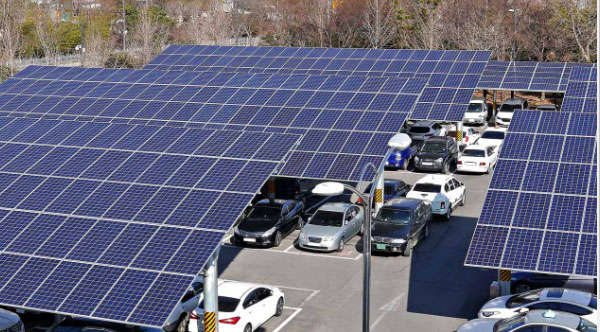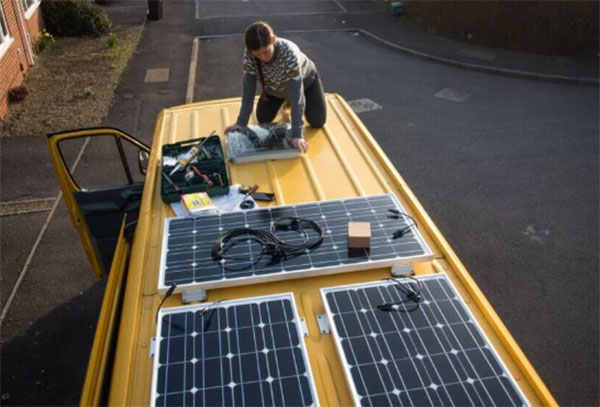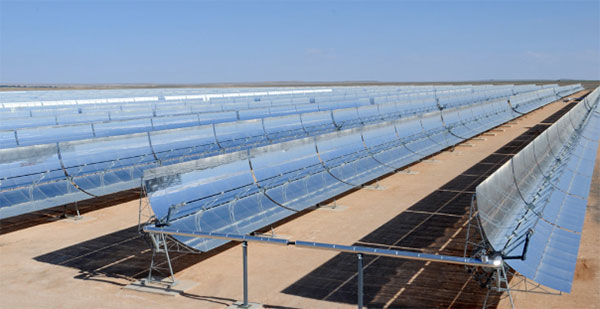Description
Yes, you can connect a solar panel to a car to enhance energy efficiency and reduce reliance on traditional fuel sources.Understanding Solar Panels and Vehicles
Solar panels harness the sun's energy, converting it into electrical power, and vehicles serve as a dynamic platform for this renewable energy source. Integrating solar panels with vehicles not only promotes energy efficiency but also paves the way for sustainable transportation solutions.Basics of Solar Energy
Solar energy is a clean and inexhaustible source of power. When solar panels, also known as photovoltaic (PV) panels, absorb sunlight, they generate electric current through the photovoltaic effect. Key Considerations:- Efficiency: A crucial parameter that determines how much sunlight is converted into usable electricity.
- Power Output: The total wattage a panel can produce, influencing the number and type of panels needed for a specific vehicle.
- Quality and Durability: High-quality materials ensure longevity and consistent performance, critical for moving vehicles exposed to varying conditions.
Types of Solar Panels Suitable for Vehicles
Selecting the right type of solar panel for a vehicle hinges on factors like efficiency, cost, weight, and aerodynamics. There are primarily three types of solar panels:- Monocrystalline Solar Panels: Known for their high efficiency and sleek design, these panels are ideal for vehicles where space and weight are at a premium. They typically have an efficiency rate of up to 22%, but their high performance comes with a higher price tag.
- Polycrystalline Solar Panels: These panels have a slightly lower efficiency, around 15% to 17%, but are more cost-effective than monocrystalline panels.
- Thin-Film Solar Panels: The most lightweight and flexible option, thin-film panels, offer unique advantages for vehicles.
Integration of Solar Panels with Vehicles
Compatibility Considerations
Before integrating solar panels into a vehicle, it's crucial to assess the compatibility between the vehicle's specifications and the solar panel's characteristics. Vehicle Specifications: Vehicles with a larger surface area, like RVs or buses, can accommodate more or larger panels, directly influencing the system's total power output. For example, a large RV might accommodate panels with a combined power output of up to 1,000 watts, while a smaller vehicle may only support 200-300 watts. Structural Integrity: The added weight of solar panels, typically around 2 to 3 kilograms per square meter, should not compromise the vehicle's structural integrity or performance. It's essential to ensure that the vehicle's design can support this additional weight without hindering its functionality. Solar Panel Characteristics: Panels with higher efficiency ratings generate more power per square meter, making them suitable for vehicles with limited space. However, these high-efficiency panels, often costing between $1.50 and $3.00 per watt, require a more substantial initial investment.Mounting and Positioning of Solar Panels on Vehicles
The mounting and positioning of solar panels are critical for maximizing energy absorption and ensuring the panels' longevity and performance. Proper alignment with the sun, secure mounting, and consideration of the vehicle's aerodynamics are paramount. Sun Exposure: Panels should be positioned to maximize exposure to sunlight. A tilt angle equal to the latitude of the location ensures optimal sun exposure throughout the year. Secure Mounting: Mounting systems must withstand various stresses, including wind resistance at high speeds. Durable mounting brackets and vibration-proof fastening systems are essential for long-term stability. Aerodynamics: The panels should complement the vehicle's design, minimizing drag and not adversely affecting the vehicle's fuel efficiency. Streamlined mounting options help maintain the vehicle's aerodynamics, crucial for vehicles frequently traveling at high speeds.Electrical Integration: Wiring and Connections
Electrical integration involves safely and efficiently connecting the solar panels to the vehicle's electrical system. This process includes selecting appropriate wiring, ensuring proper voltage and current ratings, and installing charge controllers for battery protection. Wiring and Connectors: Use high-quality, weather-resistant wiring and connectors to minimize power loss and ensure longevity. Voltage and Current Ratings: The solar system's voltage should match the vehicle's battery system, commonly 12V or 24V. Ensuring compatibility prevents overloading and potential damage to the vehicle's electrical components. Charge Controllers: A charge controller regulates the voltage and current flowing from the solar panels to the battery, protecting against overcharging and enhancing battery life. MPPT (Maximum Power Point Tracking) controllers are highly efficient, although more expensive, optimizing the power output even under varying sunlight conditions.Benefits of Solar Panels on Vehicles
Energy Efficiency and Cost Savings
Solar panels significantly enhance a vehicle's energy efficiency, translating into substantial cost savings over time. By harnessing the sun's power, these panels reduce the reliance on traditional fuel sources, leading to decreased operational costs. Reduced Fuel Consumption: Vehicles with solar panels need less fuel to operate, as the panels provide an additional power source. Prolonged Battery Life: For electric vehicles, solar panels can extend the battery's lifespan by constantly charging the vehicle during daylight hours, reducing the need for frequent plug-in charging. Cost Savings: Although the initial investment in solar panels can be substantial, ranging from $200 to $1,000 depending on the system's size and efficiency, the long-term savings on fuel and maintenance costs are significant. Over a period of 5-10 years, a vehicle owner can expect to save several thousand dollars in fuel costs alone.Environmental Impact and Sustainability
Solar panels contribute to a cleaner, more sustainable future by significantly reducing the environmental impact of vehicles. By decreasing greenhouse gas emissions and conserving non-renewable energy sources, these panels foster a more sustainable transportation sector. Reduced Carbon Footprint: Vehicles equipped with solar panels emit fewer greenhouse gases. A typical solar panel system can reduce carbon emissions by about 100 kilograms per year, contributing to a healthier environment. Conservation of Resources: By utilizing renewable solar energy, vehicles decrease their dependence on non-renewable resources like oil and gas, promoting a more sustainable and responsible use of natural resources. Promotion of Renewable Energy: The adoption of solar panels in vehicles showcases the viability and potential of renewable energy sources, encouraging further research, development, and acceptance of green technologies in the transportation sector.Challenges and Solutions
Integrating solar panels into vehicles presents a set of unique challenges. Addressing these challenges effectively is crucial to maximize the benefits of solar-powered vehicles.Overcoming Weight and Aerodynamic Constraints
Weight Management:- Lightweight Materials: Using advanced, lightweight materials for solar panels and mounting systems can minimize the weight impact.
- Structural Optimization: Designing the vehicle's structure to accommodate the additional weight without compromising on performance is crucial. This might involve using stronger, yet lighter, materials in the vehicle's construction.
- Streamlined Design: Integrating solar panels in a way that complements the vehicle's aerodynamic profile is essential. Flush-mounted panels, for example, can minimize wind resistance.
- Computational Fluid Dynamics (CFD): Employing CFD in the design process helps in understanding and minimizing the aerodynamic impact of solar panels on the vehicle.
Dealing with Variable Weather Conditions
Solar panels' performance can be significantly affected by weather conditions, making it a challenge to ensure consistent energy production. Adaptive Technologies:- Maximum Power Point Tracking (MPPT): MPPT charge controllers adjust the electrical operating point of the solar panels to ensure maximum power output under varying sunlight conditions.
- Robust Design: Ensuring that the solar panels and associated electrical components are weatherproof and can withstand conditions like rain, snow, and extreme temperatures is essential for reliability.
- Efficient Batteries: Integrating high-capacity, efficient batteries allows the vehicle to store excess energy produced during sunny periods, ensuring a steady power supply even during less sunny intervals.
Maintenance and Durability of Vehicle-mounted Solar Panels
Ensuring the longevity and performance of solar panels over time requires addressing maintenance and durability concerns effectively. Regular Maintenance:- Cleaning and Inspection: Regular cleaning of the solar panels is necessary to maintain optimal performance. Periodic inspections can help identify and rectify potential issues like cracks or loose connections before they lead to larger problems.
- Protective Coatings: Applying protective coatings can safeguard the panels against environmental damage, such as from UV radiation and physical impacts.
- Quality Components: Using high-quality components for the solar panel system can reduce the frequency and cost of maintenance. For instance, corrosion-resistant mounting hardware and UV-resistant wiring are more durable and require less frequent replacement.
Case Studies and Real-world Applications
Personal Vehicles: Success Stories and Lessons Learned
Solar-powered personal vehicles are increasingly becoming a practical and eco-friendly option for daily commuting and travel. Solar Family Cars:- Example: The Solar Family Car is a prime example, with a built-in solar panel system capable of generating up to 2 kWh per day, sufficient to cover an average daily commute of 10-20 miles. The integration of solar power significantly reduces the reliance on grid electricity and showcases the potential for self-sustaining personal transportation.
- Lessons Learned: The importance of efficient energy management and aerodynamic design is evident in these vehicles. Balancing solar power generation with battery capacity and vehicle design optimizes performance and usability.
- Example: Solar-assisted EVs, like the Tesla Model 3 with aftermarket solar roof additions, demonstrate how solar power can extend the vehicle's range and reduce charging frequency.
- Lessons Learned: These applications underline the significance of compatibility and integration between the solar power system and the vehicle's existing electrical architecture. They also highlight the potential for aftermarket solar solutions in enhancing the functionality of electric vehicles.
Commercial and Public Transportation Use Cases
Solar panels are making their mark in the commercial and public transportation sectors, promising significant fuel savings and reduced emissions. Solar-powered Buses:- Example: Cities like Adelaide, Australia, have introduced solar-powered electric buses, which operate entirely on power generated by rooftop solar panels and stored in onboard batteries. These buses showcase the potential for urban public transportation systems to shift towards renewable energy.
- Lessons Learned: The successful operation of solar-powered buses emphasizes the importance of robust energy storage solutions and the need for urban infrastructure, like solar-equipped bus stops, to support such initiatives.
- Example: The Byron Bay Railroad Company operates a 100% solar-powered train, with solar panels installed on the train and the train stations. This innovative approach demonstrates the potential for rail systems to adopt renewable energy sources.
- Lessons Learned: This case illustrates the scalability of solar power in transportation and the importance of integrating renewable energy solutions into existing transportation infrastructures.
Innovative Designs and Future Trends in Solar Vehicles
The future of solar vehicles is bright, with continuous innovations pushing the boundaries of what's possible. Solar Racing Cars:- Example: Solar racing cars, such as those competing in the World Solar Challenge, are at the forefront of innovation in solar-powered
transportation. These vehicles are designed for optimal energy efficiency and performance, setting new standards in the field.
- Future Trends: The technologies and design principles developed for solar racing are expected to trickle down to consumer vehicles, enhancing efficiency and performance. The focus on lightweight materials, aerodynamic designs, and advanced photovoltaic technology in these racing vehicles paves the way for the next generation of solar-powered transportation.
- Future Trends: The integration of solar power with autonomous and electric vehicles represents a significant step forward. C Solar panels can potentially provide the auxiliary power needed for the sensors and computational units in autonomous vehicles.
- Future Trends: Beyond vehicles themselves, the integration of solar power into urban infrastructure—such as roads and parking lots equipped with solar panels—can create a synergistic ecosystem. Vehicles can be charged during parking, and solar roads can generate electricity, contributing to a holistic sustainable urban transportation system.








